To help children cope with anxiety, start by identifying its signs, like irritability or avoidance. Use coping techniques such as deep breathing and grounding methods to calm them during anxious moments. Encourage emotional expression through art and storytelling. Create a supportive environment with clear routines to offer stability. Gradually expose them to fears and validate their feelings. If anxiety disrupts daily life, consider seeking professional help. There’s much more to explore on fostering resilience and emotional well-being.
Key Takeaways
- Encourage deep breathing exercises to help children manage anxious feelings and promote relaxation.
- Establish a daily routine to provide stability and predictability, reducing anxiety related to uncertainty.
- Use gradual exposure techniques to help children face their fears in a safe and supportive environment.
- Create open communication channels to allow children to express their thoughts and feelings without judgment.
- Incorporate physical activities and mindfulness practices into daily life to enhance emotional well-being and coping skills.
Understanding Child Anxiety
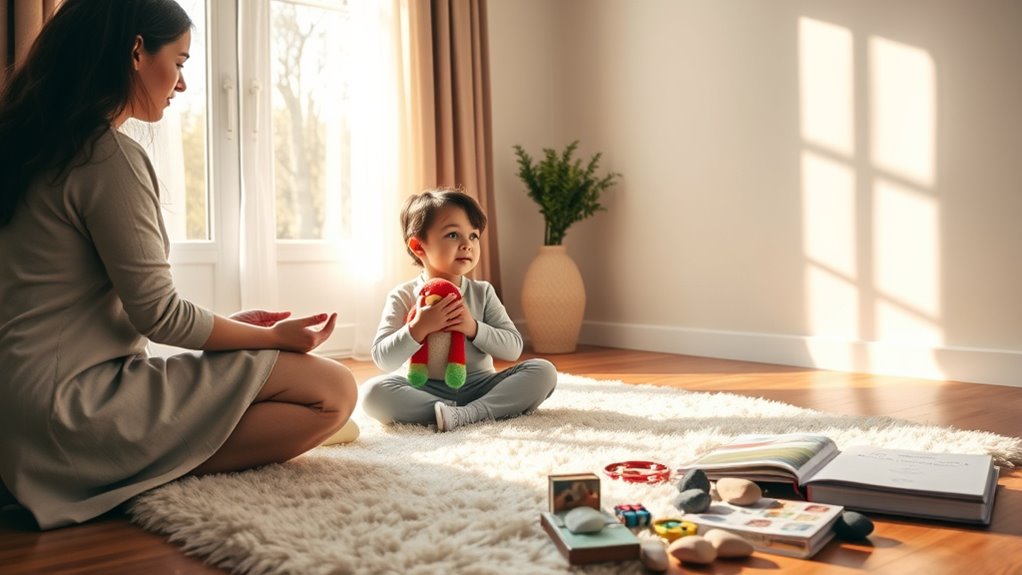
Understanding child anxiety is essential, especially since it can stem from various factors that impact a child’s emotional and social development.
Genetic predisposition plays a role, meaning anxiety can run in families. You might notice children mimicking anxious behaviors from caregivers, which reinforces their own feelings. Narcissistic abuse can also have a significant impact on a child’s emotional well-being, leading to increased anxiety levels. Additionally, the role of environmental stressors can significantly influence a child’s anxiety levels, as they often create a sense of instability. Emotional regulation is crucial for managing anxiety, as children who struggle with regulating their emotions may experience heightened anxiety. Implementing strategies to enhance self-awareness can also support children in recognizing and managing their anxiety triggers. Engaging in regular physical activity can further help children alleviate anxiety symptoms and promote emotional well-being.
Environmental stressors, like bullying or family conflicts, can further contribute to anxiety levels. Additionally, biological factors, including neurotransmitter issues, and chronic health problems can heighten anxiety risks. Anxiety is the most common mental health disorder affecting millions of young people, with 32% of adolescents in the U.S. experiencing an anxiety disorder.
A negative family environment or certain temperament traits, such as inhibition, may increase vulnerability. Finally, significant life events, like loss or relocation, also play an important role. Recognizing these causes helps you understand your child’s experience and offer appropriate support.
Identifying Anxiety in Children

How can you tell if your child is struggling with anxiety? Look for physical signs like unexplained headaches, stomachaches, or fatigue, and notice if they’ve trouble sleeping or show changes in appetite.
Emotional indicators include frequent crying, irritability, or a persistent fear of making mistakes. You might also see them avoiding activities or social situations, which can lead to meltdowns or tantrums. Additionally, normalizing feelings of worry can help your child understand that it’s okay to experience anxiety. Understanding that emotional healing takes time can also reassure them during difficult moments. Moreover, recognizing that increased smartphone usage among seniors can illustrate how technology can be a tool for connection and support, demonstrating that communication methods evolve but the need for understanding remains constant. It’s important to note that support systems like therapy can provide valuable assistance for children experiencing anxiety.
Emotional signs of anxiety in children can manifest as frequent crying, irritability, or a strong fear of making mistakes.
Consider how temporary hearing loss can also impact children’s behavior and emotional state, as they may struggle to communicate effectively or feel isolated from their peers. Pay attention to their behaviors, like needing constant approval or struggling to concentrate. Additionally, consider environmental factors such as stressful events or changes at home that could contribute to their anxiety. Furthermore, children with a borderline parent may experience heightened anxiety due to emotional instability, which can affect their coping mechanisms.
Recognizing these signs early can help you support your child effectively.
Coping Techniques for Anxiety
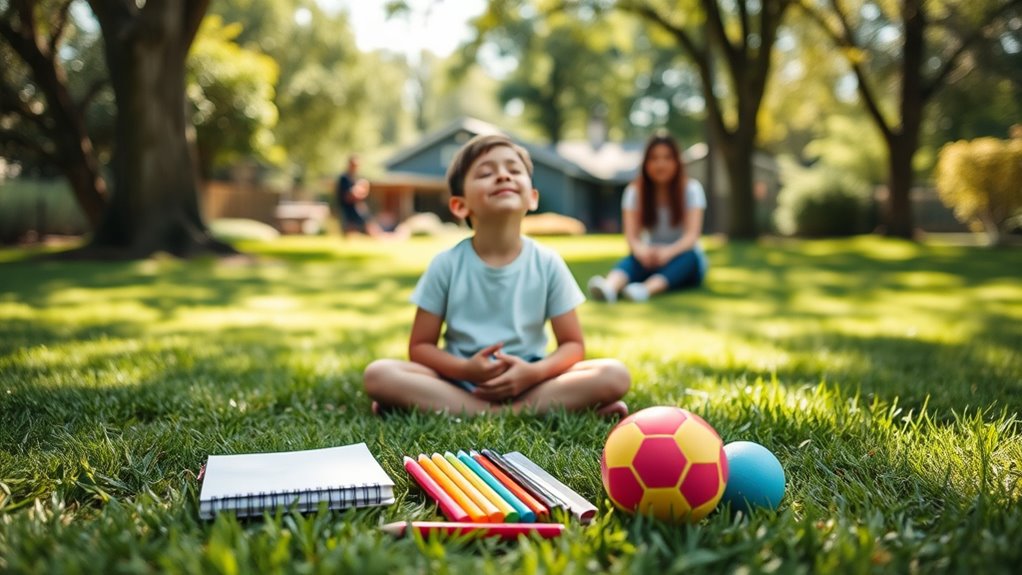
When your child feels anxious, having effective coping techniques at their disposal can make a significant difference.
Start with deep breathing exercises; encourage them to take slow breaths in through their nose and out through their mouth. You could practice slow finger tracing or use breathing rhythms for a calming effect. Additionally, incorporating 54321 Grounding technique can help them engage their senses and feel more present. Understanding how to navigate anxiety triggers can empower them to face their fears. Using predictive analytics can also help identify patterns in their anxiety, allowing for more tailored coping strategies.
Grounding techniques like using anchoring phrases or describing their surroundings can help them regain control.
Imagery and visualization, such as imagining happy places or engaging in storytelling, can soothe their mind.
Daily physical activities, whether it’s playing their favorite sport or doing short bursts of exercises, also help reduce anxiety.
Finally, establish a calming toolbox filled with comforting items to support them during tough moments.
Encouraging Emotional Expression
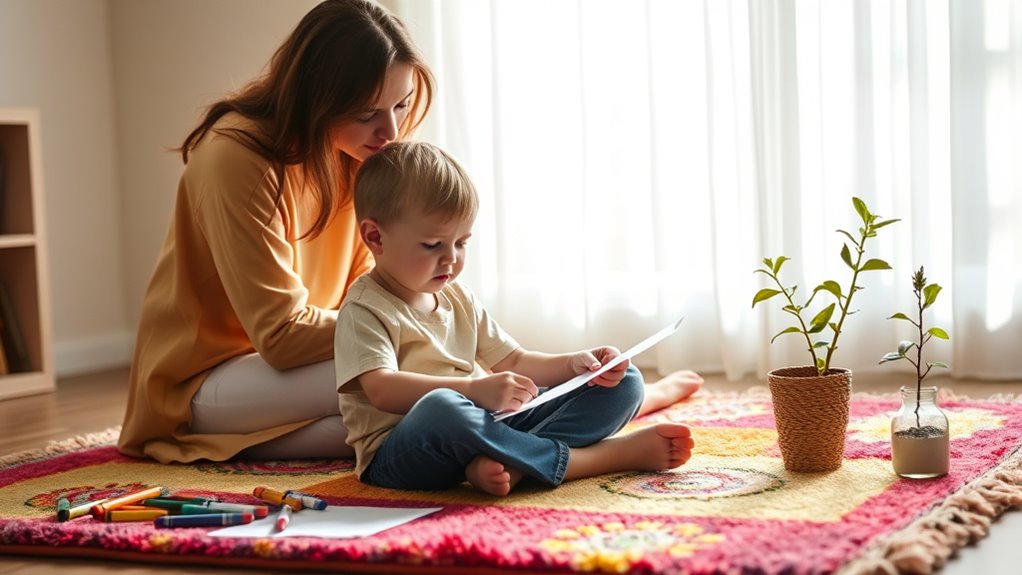
Encouraging emotional expression in children is essential for their overall well-being, as it helps them navigate their feelings more effectively. Use books and play to introduce different emotions, making it easier for them to identify their own feelings. Stress and anxiety are natural responses to challenges, and recognizing this can help children feel more comfortable expressing their emotions. Additionally, fostering resilience through navigating small mistakes can empower children to face their fears and uncertainties. Understanding the importance of clear communication can also aid children in articulating their feelings more openly. Engaging with toys such as the Learning Resources Big Feelings Pineapple can provide children with a fun way to explore and express their emotions. Moreover, shared experiences with family members can enhance emotional understanding and strengthen connections.
Building a strong emotional vocabulary is vital; teach them various emotion words to communicate better. Use mirrors or pictures to help them connect facial expressions with emotions. Regular veterinary check-ups ensure that children’s emotional health is monitored, just like physical health.
Create a safe space for open dialogue, validating their feelings and modeling healthy communication. Regular check-ins and real-time conversations about emotions normalize their expression.
Finally, encourage artistic and storytelling activities to foster emotional expression and empathy. By integrating these practices, you’ll help your child express themselves confidently and feel understood.
Strategies for Facing Fears

Facing fears can be intimidating for children, but with the right strategies, you can help them navigate these challenges effectively.
Start by validating their fears; acknowledging these feelings makes them feel understood. Encourage gradual exposure through desensitization techniques, allowing them to confront their fears step by step. Avoidance reinforces anxiety; helping them face their fears directly will empower them to regain control. Additionally, teaching them about the benefits of mindfulness practices can provide them with tools to manage anxiety in the moment. Engaging in regular physical activity can also be beneficial, as studies show that exercise promotes mental health. Just as certain foods can negatively affect pets, like grapes being toxic to dogs, it’s important to understand what can harm us emotionally and physically. Introducing sleep solutions for new parents can also help create a calming environment that supports children’s emotional well-being. Consider consulting with a healthcare provider for personalized advice on emotional readiness and coping strategies.
Help them identify what they’re afraid of and develop coping strategies like deep breathing or positive affirmations. Role-playing can also be a fun way to practice facing fears in a safe environment.
Set realistic goals to build their confidence, and remember to offer positive reinforcement for their efforts.
Creating a Supportive Environment

Creating a supportive environment is essential for helping children cope with anxiety, as it fosters safety and trust. Establish clear expectations and rules to create a structured space where kids feel secure. Encourage open communication, allowing them to express their thoughts and concerns freely. Foster peer support by promoting collaboration among students, which builds a network of understanding. Use calming colors and comfortable seating to make the classroom inviting. Regular check-ins can help you monitor their well-being, while positive communication strengthens relationships. Greet students by name to establish personal connections. Additionally, seeking professional counseling can provide tailored strategies to address their unique emotional needs. Furthermore, creating a budget plan for classroom resources can ensure that materials and activities are available to support students effectively. Incorporating wellness tracking into their daily routine can also help children become more aware of their emotions and triggers.
The Role of Routine in Reducing Anxiety
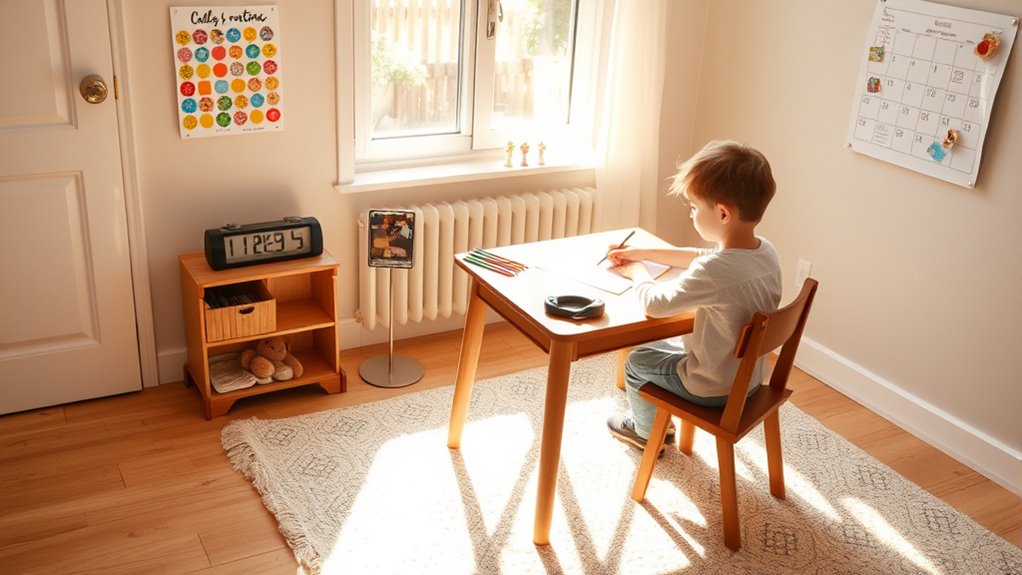
While establishing routines might seem simple, it plays a crucial role in reducing anxiety for children. Routines provide a predictable structure, helping your child feel safe and secure. When they know what to expect each day, they gain a sense of control over their environment, which reduces anxiety.
Consistent daily schedules, including wake-up and bedtime routines, stabilize emotions and minimize power struggles. During stressful times, like lockdowns, maintaining routines can greatly decrease emotional and behavioral difficulties.
Furthermore, routines foster independence and confidence, allowing children to accomplish tasks autonomously. By integrating relaxation techniques and mindfulness within these routines, you can further enhance your child’s ability to manage anxiety effectively, promoting resilience and smoother changes into adulthood.
When to Seek Professional Help
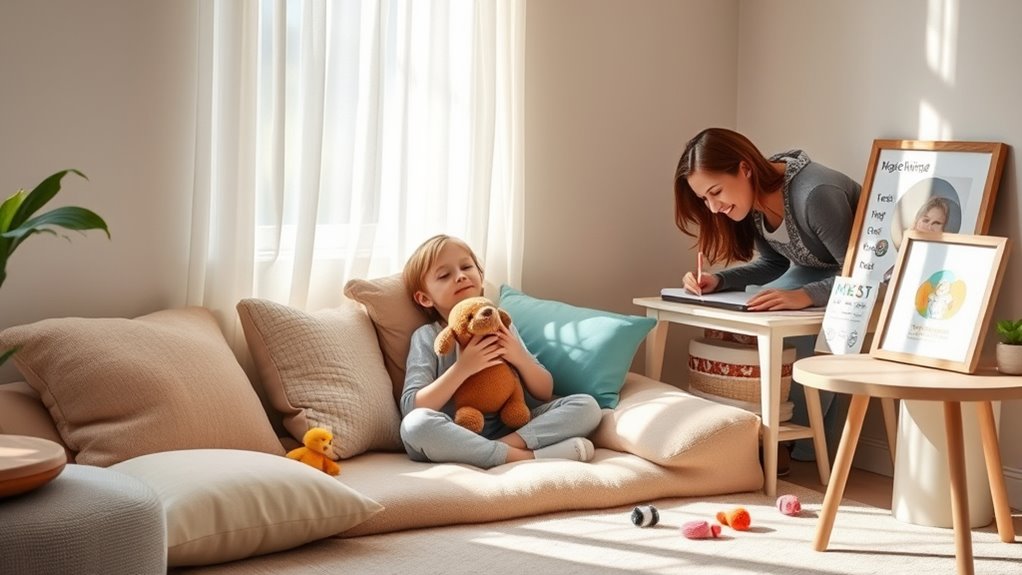
Maintaining routines can greatly help children manage anxiety, but sometimes these strategies aren’t enough. If your child experiences unmanageable anxiety that disrupts daily life—like affecting their eating, sleeping, or school performance—it’s time to seek professional help.
Look for signs such as sudden withdrawal from activities, increased irritability, or frequent crying. If your child struggles with separation from you or has overwhelming fears that lead to panic attacks, consulting a professional is essential.
A pediatrician can guide you in finding the right therapist. They can offer accurate diagnoses and effective treatments like cognitive behavioral therapy or, in some cases, medication.
Early intervention can make a significant difference in your child’s well-being.
Combining Home and Professional Strategies

Combining home and professional strategies can greatly enhance your child’s ability to cope with anxiety. Start by integrating mindfulness exercises and deep breathing techniques at home, as they help your child focus and calm their body.
Encourage physical activity to boost their mood, and establish a consistent routine for security. Meanwhile, consider professional support like cognitive-behavioral therapy (CBT), which can identify triggers and validate emotions.
Collaborate with therapists to create a structured environment that incorporates both relaxation techniques and professional guidance. Open communication with healthcare providers guarantees tailored strategies.
Additionally, art therapy can provide an emotional outlet while reinforcing coping skills. By merging these approaches, you offer your child a thorough toolkit for managing anxiety effectively.
Frequently Asked Questions
Can Diet Impact a Child’s Anxiety Levels?
Yes, diet can greatly impact your child’s anxiety levels.
Research shows that unhealthy eating patterns, particularly high sugar intake, can worsen anxiety symptoms. A balanced diet rich in protein and antioxidants helps stabilize mood and reduce cortisol levels.
Are There Specific Apps for Managing Child Anxiety?
It’s ironic how a device meant for distraction can actually help manage anxiety.
You’ll find several apps designed for children, like Calm and Positive Penguins, that guide them through relaxation and help challenge negative thoughts.
Breathe, Think, Do with Sesame teaches emotion management through fun games, while Headspace for Kids offers tailored meditations.
These tools provide accessible, engaging ways for your child to learn coping strategies anytime, anywhere, making anxiety management a little less intimidating.
How Can Schools Support Anxious Children?
Schools can support anxious children by creating a safe and welcoming environment. You can encourage open communication about feelings and provide emotional support through positive relationships.
Allow comfortable seating and breaks during class to help them relax. Breaking down tasks into manageable parts makes assignments less overwhelming.
Involve counselors for additional support and implement consistent routines to reduce uncertainty.
What Role Does Sleep Play in Anxiety Management?
Sleep’s like a soothing balm for your child’s anxious mind. When they get enough rest, their worries can melt away like snow in the sun.
Quality sleep helps regulate emotions, making it easier for them to face daily challenges. You’ll find that a consistent bedtime routine creates a comforting nest, calming their racing thoughts.
Prioritizing sleep not only improves their mood but also builds resilience against anxiety, paving the way for brighter days ahead.
How Can Siblings Help an Anxious Child?
Siblings can play an essential role in supporting an anxious child. By spending quality time together, you create a bond that helps reduce feelings of isolation.
Engaging in fun activities allows the anxious sibling to feel understood and accepted. When you listen and offer emotional support, it reinforces their resilience.
Open communication about feelings also fosters empathy and encourages a safe space where both of you can share experiences without judgment.
Conclusion
To summarize, helping children cope with anxiety is essential for their well-being. Did you know that around 1 in 8 children experience anxiety disorders? By implementing practical strategies, encouraging emotional expression, and creating a supportive environment, you can greatly reduce their stress. Remember, it’s important to maintain routines and face fears together. If you notice persistent anxiety, don’t hesitate to seek professional help. Your involvement can make a world of difference in their journey towards emotional resilience.









